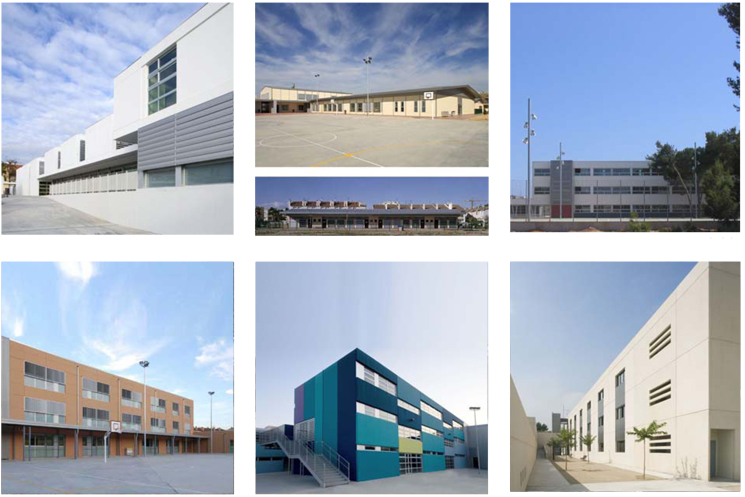Since 2002 over a hundred public schools have been built in Catalonia using prefabricated systems. Most of them serve as examples a well-constructed prefabricated architecture and they have drawn the author’s interest.
The author chose these schools as his thesis topic, and during his research the author has found 138 kindergarten and elementary sample prefabricated schools. Half of these samples were built between 2002 and 2006, as a specific project by the Catalan Education Department. But the other half had been built between 1970 and 1983, together with hundreds of other schools that had been built all over Spain according to central govern deals called “Pactos de la Moncloa”.
Mainly, this thesis studies kindergarten and elementary centers built almost entirely out of prefabricated pieces between the years 1970 and 2006. More concretely, the author limited his study to prefabricated schools built in Catalonia which permitted a more in-depth study of the sample buildings and their systems by means of the resources at hand. Moreover, the schools built from 2006 to 2008 were discarded because they didn’t improve the sample, and this was the way to get an historical view of the centers selected.
This investigation started with three hypotheses: the schools included in the sample are a kind of building well-suited to prefabrication, prefabricated technology will prove to be the only one capable of producing these schools within time frame and budgetary constraints, and this prefabricated architecture has had a positive but irregular evolution. These hypotheses have been corroborated in this project, which has been developed in three main parts. First, samples are catalogued; second, samples are analyzed, and finally, the author draws his conclusions.
In the process to catalogue the educational centers selected, the author carried out field research which included visits to schools, construction industries, archives… This research allowed the author to catalogue this documentation, what has been done into three types of files: a general study of the 138 schools; a detailed catalogue of the 12 construction systems used to build these centers; and an in-depth study of the most representative school built with each construction system.
Following this catalogue, the author presents his analysis, which starts with a historical review of prefabricated Spanish schools, with emphasis on the details developed in Catalan schools. In continuation, the author analyzes the samples from the same three points of view used previously while cataloging the sample schools. For this purpose, sketches, diagrams, graphics, tables… have been incorporated. This methodology has been successfully applied and is considered appropriate for use in other studies of prefabricated buildings.
The third section of this thesis presents the conclusions based on the analyses undertaken; from these, the author draws some recommendations for the construction of prefabricated schools in the future. Both proposals presented are based on rationality and they avoid subjective approaches to the prefabricated world. Furthermore, the author considers that the majority of his recommendations and conclusions can be applied to constructing prefabricated schools throughout the country.
This research project proves that prefabricated construction systems are well-suited for schools, and their evolution has been positive but irregular. As well, the author recommends a revision be undertaken on the currently available systems in order to maximize their outcome. This redesign should consider the previous experiences and adapt these systems according to future necessities, based on teamwork by all the professionals who have worked in constructing schools with prefabricated materials.
To these ends, included in the author’s recommendations there are the reviews and sketches of new technologies which could solve the weak points of the current systems: to be able to prefabricate and assemble an entire building, to use components with improved quality and applications, to permit connections and joints which are easier to execute and seal, to allow disassemble methods without destroying components so these may be reused…
Finally, this thesis shows the qualities of a new technology for today’s architecture, one closer to the values of our society: security, temporality, environmental awareness… The current crisis in construction could be an ideal moment to reflect on the need to design and build employing a more up-to-date, innovative construction technology.





